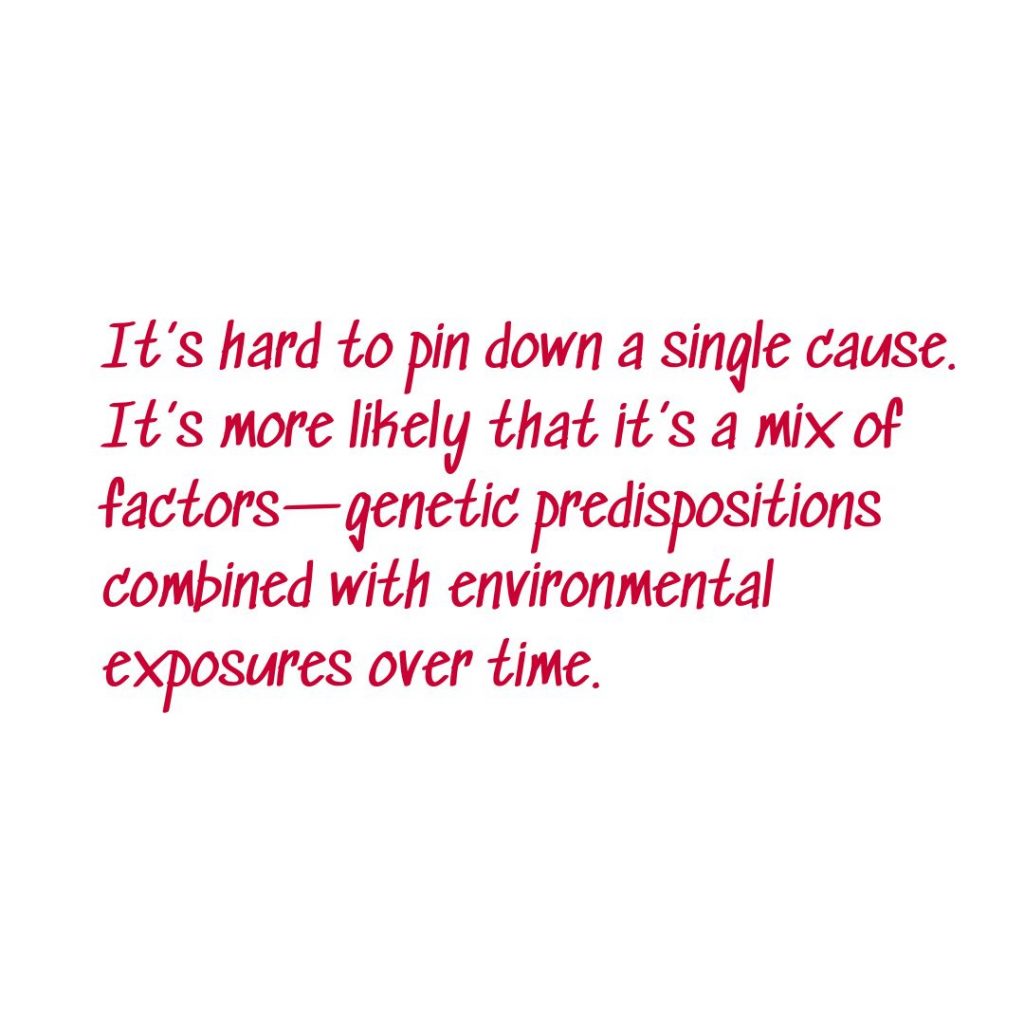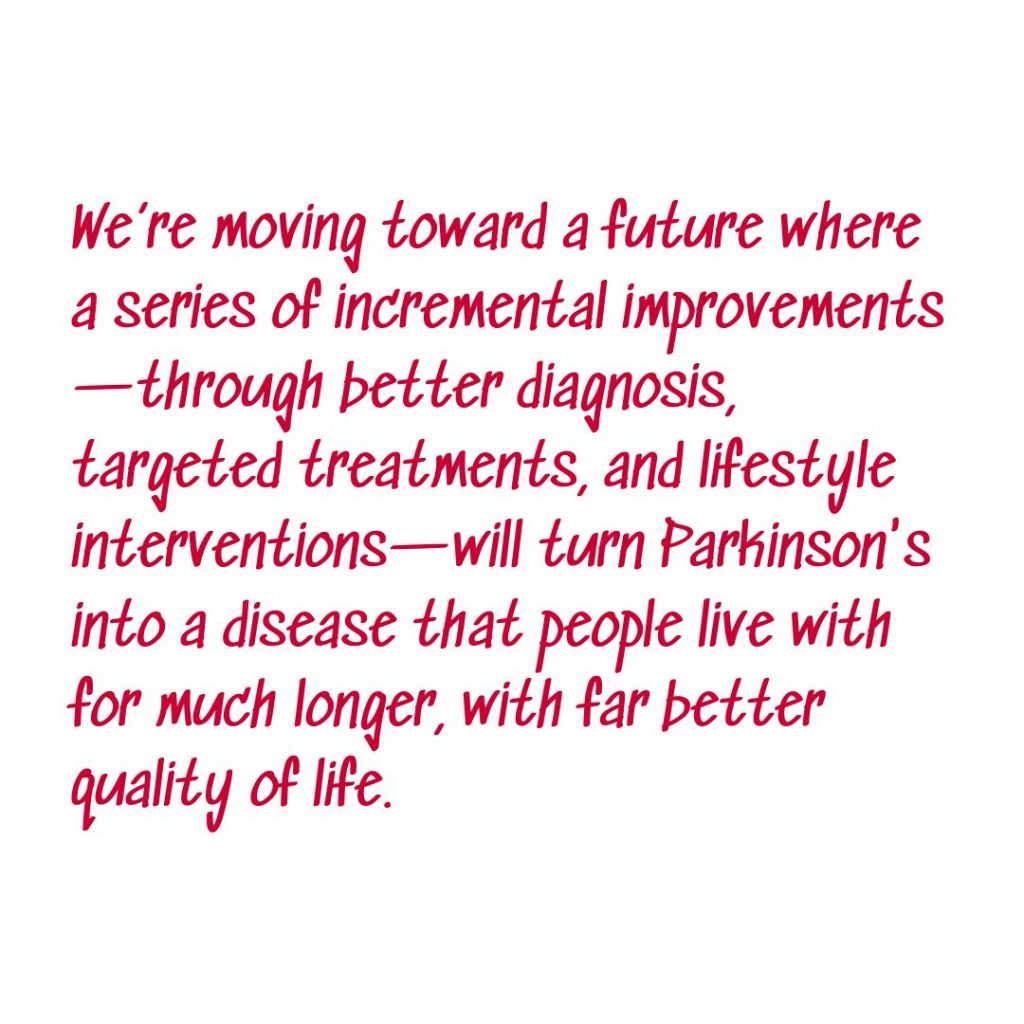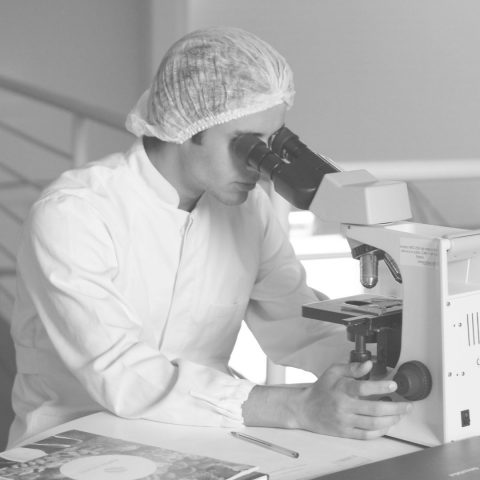 Demoucelle Parkinson Charity board member Dr. Ian Reynolds is a neuropharmacologist and has over 20 years of drug discovery and development experience. He is a member of the Scientific Advisory Boards of Aligning Science Across Parkinson’s and SPARK NS, and regularly advises the Michael J. Fox Foundation, Target ALS and the Parkinson’s Foundation. His career spans academia, start-up enterprises in neuroscience drug discovery and multi-national pharmaceutical companies.
Demoucelle Parkinson Charity board member Dr. Ian Reynolds is a neuropharmacologist and has over 20 years of drug discovery and development experience. He is a member of the Scientific Advisory Boards of Aligning Science Across Parkinson’s and SPARK NS, and regularly advises the Michael J. Fox Foundation, Target ALS and the Parkinson’s Foundation. His career spans academia, start-up enterprises in neuroscience drug discovery and multi-national pharmaceutical companies.
Anne-Marie asked him to explain what is known about the causes of Parkinson’s disease. Their conversation is below. We hope it is helpful and inspiring.
Together we can beat Parkinson’s!
—————–
*** The number of Parkinson’s patients has doubled in the last 25 years, and experts project it will double again over the next 25. What’s driving this trend?
When we see a rise in the incidence of a disease, one possibility is that it could be due to better diagnosis. While early Parkinson’s can be subtle, as it progresses, it becomes clear, and the accuracy of diagnosis is already quite high. So, I don’t think improved detection is the main factor here.
Parkinson’s is an age-related disease, so naturally, as people live longer, we see more cases. But when you account for the growing number of older adults, the incidence of Parkinson’s is still increasing. It’s not just because people are living longer; there’s something else going on.
Some call it a “pandemic” of Parkinson’s, but I’m not fond of that term. True pandemics are sudden and acute; this is a slower, long-term increase, but the rise is undeniable.
The question now is: why? And that’s where things get complicated.
*** Does that mean one of the causes of Parkinson’s is increasing? What do we know about the causes of Parkinson’s?
From a scientific standpoint, the short answer is that we don’t know for sure what causes Parkinson’s. But we’ve learned a lot, particularly in genetics, over the last decade or so. There are specific genetic mutations—rare ones—that almost guarantee a person will develop Parkinson’s, with a probability as high as 90%. These mutations aren’t common, but if you have one, like in the alpha-synuclein gene or certain mitochondrial genes, your risk skyrockets.
Beyond that, there are around 20-30 genes that significantly modify the risk, and another 80 or so that might slightly influence it. For instance, mutations in the LRRK2 or GBA genes can increase your risk by 8 to 10 times, but it’s still not a certainty. Some people with these mutations never develop Parkinson’s.
 In addition to genetics, there’s also the role of environmental toxins. In the 1980s, for example, a group of people in San Francisco accidentally injected themselves with a toxin, MPTP, while trying to make a synthetic drug. They developed a Parkinson’s-like syndrome almost instantly, which showed us that toxins can trigger the disease. Pesticides, dry-cleaning chemicals, even air pollution—there’s evidence that exposure to these can raise your risk.
In addition to genetics, there’s also the role of environmental toxins. In the 1980s, for example, a group of people in San Francisco accidentally injected themselves with a toxin, MPTP, while trying to make a synthetic drug. They developed a Parkinson’s-like syndrome almost instantly, which showed us that toxins can trigger the disease. Pesticides, dry-cleaning chemicals, even air pollution—there’s evidence that exposure to these can raise your risk.
But it’s hard to pin down a single cause. It’s more likely that it’s a mix of factors—genetic predispositions combined with environmental exposures over time. Head injuries, like those experienced by Muhammad Ali, have also been linked to Parkinson’s. This all points to a complex interplay between genetics and environment.
*** Is it possible to explain why some people develop Parkinson’s and others don’t?
That’s the tricky part. We don’t fully understand how genetics and environment interact. Some people might have genetic resilience—they can handle exposure to toxins or other environmental risks better than others. It’s possible that one person’s body can adapt to pesticides or pollution, while another person’s body—maybe because of a genetic mutation—struggles to cope, and that’s when damage begins.
It would be great if we could identify these risks clearly because reducing environmental exposure would be the fastest way to lower the incidence of Parkinson’s. But we don’t yet have the tools to measure that interaction between genes and the environment well enough. It’s an area that’s ripe for further study.
*** Parkinson’s is often said to be ‘not just one disease but a collection of different types’. Can you explain this more, in particular how some cases begin in the gut and others in the brain?
That’s an intriguing area of research. There’s growing evidence that Parkinson’s might begin in different parts of the body. Some scientists have suggested that for some patients, the disease could start in the gut. Constipation, for instance, can be an early symptom, showing up years before the more classic motor symptoms like tremors or stiffness. Pathological signs like Lewy bodies, which are protein clumps found in Parkinson’s, have been found in the gut’s nervous system as well.
There’s also research into the microbiome—the population of microbes in our gut—and whether changes in that population could play a role in triggering or influencing the disease. The idea is that these changes might cause pathology to spread from the gut to the brain via the vagus nerve, which connects the two. This “gut-brain” hypothesis has gained traction, but it’s still a hypothesis, not a proven fact.
It’s possible that Parkinson’s can start in the gut for some and in the brain for others, but it’s also possible that what we’re seeing are different manifestations of the same disease, just starting in different places. This is still an active area of research, and we have more questions than answers at this point.
*** Is there anything people can do to reduce their risk of developing Parkinson’s?
That’s a question I get asked a lot. I tend to be cautious with recommendations because lifestyle changes can be burdensome, and we don’t want to create unnecessary stress for people. But there are some reasonable precautions. For instance, I’d think carefully about pesticide exposure. If you live in an area where pesticides are used, or if you garden, consider alternatives to chemical sprays. Avoiding head injuries is another obvious precaution.
There’s also some evidence linking caffeine to a lower risk of Parkinson’s. Studies have shown that more caffeine consumption is associated with reduced risk. Smoking, oddly enough, has also been linked to a lower risk, but given all the other dangers of smoking, that’s not something we recommend.
Exercise seems to be a common protective factor. People with Parkinson’s often find that staying active helps manage symptoms, and it stands to reason that regular physical activity could help delay or prevent the onset of the disease as well.
As for dietary supplements like antioxidants, despite the hype, there’s very little evidence that they make a significant difference. Studies on vitamin C, vitamin E, and CoQ10, for example, haven’t shown clear benefits in preventing Parkinson’s. So, it’s crucial to weigh the costs and potential benefits before making changes.
*** What impact does the complex nature of Parkinson’s disease have on research? How hopeful can we be about disease-modifying treatments in the near future?
That’s a critical question, and despite all the complexities we’ve discussed, I remain very optimistic about the future of Parkinson’s research and treatment. There are a few reasons for this optimism.
First, genetic research is providing us with valuable insights. While only about 15% of Parkinson’s cases are driven primarily by genetic mutations, understanding these genetic factors gives us potential targets for treatments. For example, there are trials underway right now focused on people with mutations in the LRRK2 gene, which increases Parkinson’s risk. Even if only a small percentage of people carry this mutation, the results of these trials could be relevant to many others because the pathways involved might also play a role in non-genetic cases of Parkinson’s.
Parkinson’s is a progressive disease that unfolds over many years, so one of our goals is to slow that progression. While stopping the disease entirely before symptoms emerge is extremely difficult—since we still don’t fully understand the initial triggers—we can target what happens after those triggers set the disease in motion. Once the neurodegeneration begins, there’s a cascade of events like inflammation, mitochondrial dysfunction, and loss of dopamine-producing neurons. These are areas we can study and potentially intervene in.
Even if we can’t stop the disease at the earliest stage, slowing its progression could still have a profound impact on patients’ lives.
For instance, the difference between mild and severe symptoms is often just a small variation in how many dopamine neurons remain functional. So, if we can preserve even a small number of those neurons, it could make a big difference in how the disease manifests.
 We’re exploring several approaches—reducing inflammation, improving mitochondrial function, or even protecting dopamine neurons—that could potentially slow the progression and give people more quality years before the disease severely impacts their lives.
We’re exploring several approaches—reducing inflammation, improving mitochondrial function, or even protecting dopamine neurons—that could potentially slow the progression and give people more quality years before the disease severely impacts their lives.
In research, there’s rarely a “magic bullet.” Much like what we’ve seen with cancer treatment, progress often comes from combining different therapies that work together. Cancer treatment has gone from being a death sentence to, in many cases, a manageable chronic condition. I think Parkinson’s will follow a similar path. We’re moving toward a future where a series of incremental improvements—through better diagnosis, targeted treatments, and lifestyle interventions—will turn Parkinson’s into a disease that people live with for much longer, with far better quality of life.
So, while we may not yet be at the point of curing Parkinson’s, I believe we’re on the path to significantly altering its course for the better in the coming years.
